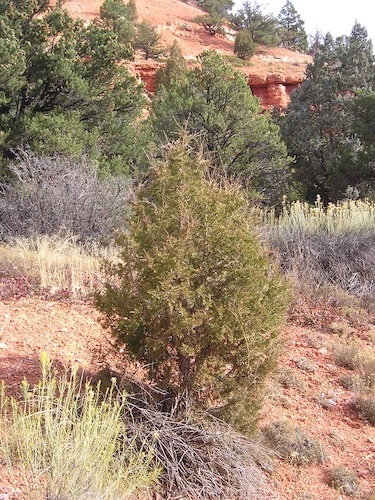The Chronicles Of Grant County
Juniper Avenue – Reserve
Juniper Street – Silver City
 A Juniper Tree in the Dixie National Forest in Cedar City, Utah. (The photograph was provided courtesy of the United States Forest Service.)
A Juniper Tree in the Dixie National Forest in Cedar City, Utah. (The photograph was provided courtesy of the United States Forest Service.)
Juniper Street in Silver City, Grant County, and Juniper Avenue in Reserve, Catron County, get their names from the Juniper tree.
"The Juniper tree is typically found in areas that have an elevation between 3,000 and 8,000 feet," according to a statement issued by the United States Forest Service (FS) of the U S Department of Agriculture (USDA). "This tree grows among the pinyon pine trees and sagebrush. The short scale-like needles are one-eighth inch long and last several years. Foliage and branches are stiff. Seeds are borne in berry-like scaled cones. The cones, when mature, are up to a half-inch in diameter and bronze in color with a bluish-white frosting."
Among locales with this type of tree is the Gila National Forest.
The United States Geological Survey (USGS), in quoting from a report issued by the Rocky Mountain Forest and Range Experiment Station of the FS of the USDA, noted that "Pinyon-Juniper woodlands are one of the largest ecosystems in the Southwest and in the Middle Rio Grande Basin…The woodlands have been important to the region's inhabitants since prehistoric times for a variety of natural resources and amenities."
"The ecosystems have not been static; their distributions, stand characteristics, and site conditions have been altered by changes in climatic patterns and human use and, often, abuse," the statement being quoted continued. "Management of these lands since European settlement has varied from light exploitation and benign neglect, to attempts to remove the trees in favor of forage for livestock, and then to a realization that these lands contain useful resources and should be managed accordingly."
According to a news release from the Bureau of Land Management of the U S Department of the Interior issued on December 9, 2020, "Pinyon and Juniper species can be aggressive invaders of other vegetation communities. Scientists estimate that Pinyon and Juniper woodlands occupied less than 7 million acres prior to [the more recent] settlement of the West in the 1870s. They now occupy over 74 million acres across the West. At the same time, sagebrush ecosystems occupy only about one-half of their historical distribution."
The Juniper tree is quite hardy, according to a statement from the National Park Service.
In this statement, issued on November 20, 2020, referencing the Canyonlands National Park in Utah, the Federal agency indicated that "the Juniper can withstand drought conditions that often kill other plants and trees. Its hidden secret: a massive underground root system which can account for two-thirds of a tree's total mass. A Juniper's tap root can penetrate 25 feet straight down in search of water. It can also send out lateral roots 100 feet or more from the tree. The roots are especially hardy: even when knocked over by wind, Junipers often continue to grow."
"Junipers grow very slowly," this statement continued. "A Juniper standing only five feet tall may be 50 years old. Junipers typically live from 350 to 700 years, with some even passing the millennium mark. Despite their longevity, Junipers rarely exceed 30 feet in height or three feet in diameter."
The National Park Service noted that "no two Junipers ever seem to look alike: some are bushy, some have multiple trunks, and many have poorly-formed crowns that are a mixture of live and dead branches. To conserve water Junipers can self-prune, stopping the nutrient supply to one branch in order to ensure the survival of the tree."
The Juniper tree provides nourishment for a variety of wildlife.
"Animals find the Juniper very inviting," according to the statement from the National Park Service. "The berries are edible, though they are not as popular as pinyon pine nuts. However, Juniper berries are a staple for jackrabbits, coyotes, and a variety of birds. This is important for the tree as well since it helps to disperse its seeds."
The Federal agency also indicated that human beings have found a number of uses for the Juniper tree.
For example, the National Park Service detailed that people of the Native Nations make use "…of the Juniper's medicinal qualities, which include the treatment of stomach aches, coughs, and headaches. The dried seeds can be used for beading necklaces and bracelets and as the 'rattle' in rattles. Juniper logs are used to build ceremonial hogans and other structures. Pioneers and cowboys found the rot-resistant wood great for fence posts and shingles, and it has long been favored for firewood. The soft bark has been used as bedding, toilet paper, and, when tightly twisted, as a slow-burning match."
Do you have questions about communities in Grant County?
A street name? A building?
Your questions may be used in a future news column.
Contact Richard McDonough at chroniclesofgrantcounty@mail.com.
If your email does not go through, please contact editor@grantcountybeat.com.
© 2023 Richard McDonough